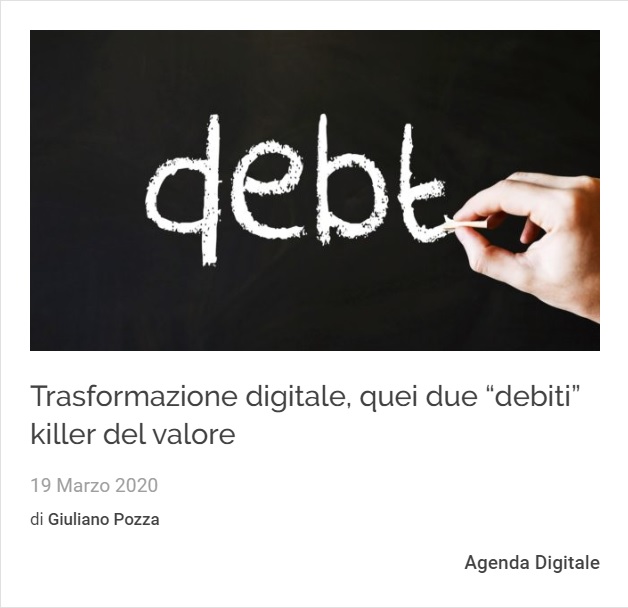NOTA: Per approfondimenti o per avere copia degli articoli citati e non direttamente accessibili tramite il link contattatemi.
Articoli e contributi
Scuola Digitale: perché la primaria può guidare l’evoluzione del Sistema Educativo
Scuola digitale, perché la primaria può guidare l’evoluzione del sistema educativo
Algocrazia: i nuovi algoritmi alla conquista del mondo (contributo per Agenda Digitale)
Riflessione ulteriore sulla Customer Experience in sanità:
Sintesi del mio contributo al libro di ASSD:
Value-Based Customer Experience: l’innovazione che non c’è in sanità (sia prima che dopo il coronavirus)
La sorveglianza digitale e il nuovo Panopticon:
Panopticon, ovvero come stiamo realizzando il sogno di ogni regime totalitario
Big data e small data contro il coronavirus: una proposta per l’Italia
L’AI maligna che ci salverà dal Coronavirus – Opportunità e dilemmi etici
Intervista su G.and.A.L.F. a Radio Next (Radio 24)
Governance della trasformazione digitale, cambiare approccio col metodo “Gandalf”: ecco come
Sanità digitale alla svolta “Value Based”: i vantaggi e le sfide etiche
I due lati oscuri della Sanità digitale: il super-controllo e le diseguaglianze
Competenze di leadership in Sanità digitale: così recuperiamo il ritardo italiano
Sanità digitale tra innovazione e realtà: la visione di un C.I.O. (Ottobre 2018)
Perchè l’e-Health non ci basta più (Panorama Sanità – Giugno 2018)
Healthcare Security—Three Paradoxes and the Need for a Paradigm Shift (ISACA Journal – Vol. 3 2018)
Il C.I.O. è morto, lunga vita al C.I.O. (Ottobre 2017 – Forum PA)
Beyond BYOD (Settembre 2014 – ISACA Journal)
A social approach to IT Governance (Agosto 2014 – ISACA JOnline)
Communicating IT Governance: does it matter? (Aprile 2014 – ISACA JOnline)
Corsi e presentazioni:
Strumenti di Collaborazione in ambito clinico: dal burn-out alla co-creazione di valore
Corso-e-HealthAcademy-GandALF (edizione 2019)
Convegno Clinical Pacing Roma – Cybersecurity In Healthcare (Dic. 2018)
Corso “eHealth tra innovazione e realtà” (Ist. Carlo Iemolo – 2017 – Roma)
Bibliografia personale sulla sanità digitale e dintorni (ovvero: una selezione degli autori che ho incontrato e apprezzato durante il cammino)
Healthcare:
Christensen, C. (2009). The Innovator’s Prescription. McGraw-Hill Professional.
Giunco, F. (2014). Abitare Leggero. Verso una nuova generazione di Servizi per gli anziani. Quaderni dell’osservatorio della Fondazione Cariplo.
Halamka, J. D. (n.d.). Retrieved 1 25, 2014, from Life as a Healthcare CIO: http://geekdoctor.blogspot.com/
Halamka, J. D. (2014). Geekdoctor: Life as a Healthcare CIO. HIMSS.
5 Technologies Bringing Healthcare Systems into the Future
M. E. Porter, E. O. Teisberg (2006). Redefining Health – Harvard Business School Press
The C.I.O.’s role
Broadbend, M; Kitzis, E (2004). The New CIO Leader: Setting the Agenda and Delivering Results. Harvard Business School Press.
Aron, D; Graha, W (2014). Taming the Digital Dragon: The 2014 CIO Agenda. Retrieved from https://www.gartner.com/imagesrv/cio/pdf/cio_agenda_insights2014.pdf
Heller, M (2012). The CIO Paradox: Battling the Contradictions of IT Leadership. Bibliomotion Inc.
De Marco, M; Occhini, G; Bellini, R. The Evolving Role of CIOs in Changing Business Settings from 1980 to 2010: Literature Review and Emerging Trends. IFIP Congress – Shenzen 2011
Waller, G., Hallenbeck, G., & Rubenstrunk, K. (2010). The CIO Edge: 7 Leadership Skills You Need to Drive Results. Harvard Business School Press.
Governance:
ISO. (2008). ISO 38500. Retrieved from 38500: http://www.38500.org/
ISACA. (2014). IT Governance Institute. Retrieved from ITGI: www.isaca.org
ISACA. (2014). CGEIT Review Manual 2014. ISACA.
Sriram Narayan (2015). Agile IT Organization Design. Addison-Wesley
Carr, N. G. (2003, May). IT Doesn’t Matter. Harvard Business Review.
Holt, A. L. (2013). Governance of IT: An Executive Guide to ISO/Iec 38500. BCS.
McFarlan, F. W., & Nolan, R. L. (2003, August 25). Why IT Does Matter. Retrieved December 2, 2013, from Harvard Business School Working Knowledge: http://hbswk.hbs.edu/item/3637.html
Parkinson, M. J., & Baker, N. J. (2005). IT and Enterprise Governance. Information Systems Control Journal, 3.
Plant, R. (2013, August 15). IT Doesn’t Matter (to CEOs). Retrieved December 5, 2013, from http://blogs.hbr.org/2013/08/it-doesnt-matter-to-ceos/
Porter, M. (2001). Strategy and the Internet. Harward Business Review.
Ross, J. W., & Weill, P. (2006). Enterprise Architecture As Strategy. Harvard Business School Press.
Ross, J. W., & Weill, P. (2009). IT Savvy. Harvard Business School Press.
Grimes, S. L. (2006, August 24). Convergence of Clinical Engineering and Information Technology. Retrieved from ACCE (American College of Clinical Engineering): http://www.accenet.org/downloads/chime.pdf
ISA. (2008, 5). MES ownership up in air. Retrieved from ISA: http://www.isa.org/InTechTemplate.cfm?Section=Communities&template=/TaggedPage/DetailDisplay.cfm&ContentID=69056
Sholten, B., Filho, C. S., & Smits, E. (2012). Who Owns Information Systems in the Plant? Retrieved from Accenture: http://www.accenture.com/SiteCollectionDocuments/PDF/Accenture-MES-Who-Owns-Information-Systems-plant.pdf
United Kingdom’s Cabinet Office. (n.d.). Retrieved 01 24, 2014, from ITIL official web site: http://www.itil-officialsite.com/
Weill, P., & Ross, J. W. (2004). IT Governance: How Top Performers Manage IT Decision Rights for Superior Results. Harvard Business School Press.
The future of IT:
Hunter, R. (2013). The Future of Global Information Security. Gartner.
Rifkin, J (2014). The Zero Marginal Cost Society. Palgrave Macmillan
ICSPA. (2013). Project 2020: Scenarios for the Future of Cybercrime – White Paper for Decision Makers. Retrieved from 2020: http://2020.trendmicro.com
Kurzweil, R. (2005). The Singularity Is Near: When Humans Transcend Biology. Viking.
TrendLabs. (2013). BLURRING BOUNDARIES – Trend Micro Security Predictions for 2014 and Beyond.Trend Micro.
Leadership and competencies:
CEN. (2012). CWA 16458. Brusselles: European Committee for Standardization. Retrieved from CEN WORKSHOP AGREEMENT.
CEN. (2014). e-CF. Retrieved from http://www.ecompetences.eu/
e-CF. (2014). e-CF: ICT Professional Profiles. Retrieved December 6, 2013, from European e-Competences Framework: http://www.ecompetences.eu/
Gareis, K., Husing, T., Birov, S., Bludova, I., Shultz, C., & Korte, W. (2014). e-Skills for jobs in Europe: measuring progress and moving ahead – Final Report . Brusselles: Empirica.
Goleman, D. (2013, December). The Focused Leader. Harvard Business Review.
Austin, R. D., Nolan, R. L., & S., O. (2009). Adventures of an IT Leader. Harvard Business Press.
Kotter, J., & Rathgeber, H. (2006). Our Iceberg Is Melting. Macmillan.
Kotter, J. (2012). Leading Change.
Kotter, J. (1997). Matsushita Leadership.
Security in healthcare:
HIPAA Journal, “Major 2016 Healthcare Data Breaches: Mid Year Summary,” HIPAA Journal, 11 July 2016, https://www.hipaajournal.com/major-2016-healthcare-data-breaches-mid-year-summary-3499/
Clusit, Rapporto Clusit 2018 sulla sicurezza ICT in Italia, CLUSIT, Italy, 2018
Houlding, D.; “6 Most Common Types of Healthcare Data Security Breaches,” IT Peer Network, 18 February 2016, https://itpeernetwork.intel.com/6-most-common-types-of-healthcare-data-security-breaches/
DeGaspari, J.; “Managing the Data Explosion,” Healthcare Informatics, 1 October 2013, www.healthcare-informatics.com/article/managing-data-explosion
Earle, N.; “Do You Know the Way to Ballylickey? Shadow IT and the CIO Dilemma,” Cisco Blogs, 6 August 2015, https://blogs.cisco.com/cloud/shadow-it-and-the-cio-dilemma
Rogers, M.; “The Shadow IT Phenomenon,” Logicalis, https://www.us.logicalis.com/globalassets/united-states/whitepapers/cio-survey-2015-shadow-it-phenomenon.pdf
Babbar, P.; A. Hemal; “Robot-Assisted Urologic Surgery in 2010—Advancements and Future Outlook,” Urology Annals, 2011, vol. 3, no. 1, www.urologyannals.com/article.asp?issn=0974-7796;year=2011;volume=3;issue=1;spage=1;epage=7;aulast=Babbar
Food and Drug Administration, “Is The Product A Medical Device?” USA, www.fda.gov/MedicalDevices/DeviceRegulationandGuidance/Overview/ClassifyYourDevice/ucm051512.htm
Lemke, H.; M. Vannier; “The Operating Room and the Need for an IT Infrastructure and Standards,” International Journal of Computer Assisted Radiology and Surgery, November 2006, vol. 1, no. 3, p. 117-121
Food and Drug Administration, Firmware Update to Address Cybersecurity Vulnerabilities Identified in Abbott’s (Formerly St. Jude Medical’s) Implantable Cardiac Pacemakers: FDA Safety Communication, USA, 29 August 2017, https://www.fda.gov/MedicalDevices/Safety/AlertsandNotices/ucm573669.htm
Sholten, B.; C. S. Filho; E. Smits; “Who Owns Information Systems in the Plant?” Accenture, 2012, https://www.accenture.com/t20150624T211125__w__/in-en/_acnmedia/Accenture/Conversion-Assets/DotCom/Documents/Global/PDF/Industries_10/Accenture-MES-Who-Owns-Information-Systems-Plant.pdf
US Department of Health and Human Safety, Office of Civil Rights, “Cases Currently Under Investigation,” https://ocrportal.hhs.gov/ocr/breach/breach_report.jsf
Grimes, S. L.; “Convergence of Clinical Engineering and Information Technology,” 24 August 2006, http://accenet.org/publications/Downloads/Presentations/chime.pdf
ECRI Institute, Top 10 Health Technology Hazards, ECRI, 2018
Ridley, E. L. (2012, 4 6). Imaging devices present hidden security risks. Retrieved from AuntMinnie: https://www.auntminnie.com/index.aspx?sec=ser&sub=def&pag=dis&ItemID=98957
… and more:
Turkle, S. (2012). Alone Together: Why We Expect More from Technology and Less from Each Other.
Boyd, D (2015). It’s Complicated. (http://www.danah.org/books/ItsComplicated.pdf)
Varanini, F. (2016). Macchine per pensare: l’informatica come prosecuzione della filosofia con altri mezzi (Guerini)
Lindstrom, M. (2016). Small Data (Hoeply)
Watzlawick, P. (1976). How Real Is Real?
Watzlawick, P; Weakland, J; Fisch, R.. (1978). Change.
Turing, A. (1950). Computing machinery and intelligence (http://www.loebner.net/Prizef/TuringArticle.html)
Gotterbarn (et Al.). ACM Code of Ethics (https://www.acm.org/about-acm/acm-code-of-ethics-and-professional-conduct)
G. Mulgan (2018). Big Mind (Ed. Codice)
Keeley. Ten Types of Innovation: The Discipline of Building Breakthroughs (2018). Ed. John Wiley & Sons
Renée Mauborgne, W. Chan Kim. Blue Ocean Strategy (2015). Ed. Harvard Business Review
Accoto. Il mondo dato (2018). Ed. Egea
Kaplan, R. S., & Norton, D. P. (2008). The Execution Premium: Linking Strategy to Operations for Competitive Advantage. Harvard Business Review Press.





